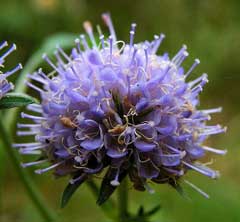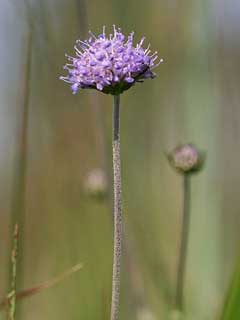 |
|
http://commons.wikimedia.org/wiki/User:Bff |
 |
| http://commons.wikimedia.org/wiki/User:Fabelfroh |
Translate this page:
Summary
Physical Characteristics

 Succisa pratensis is a PERENNIAL growing to 0.4 m (1ft 4in).
Succisa pratensis is a PERENNIAL growing to 0.4 m (1ft 4in).
See above for USDA hardiness. It is hardy to UK zone 5. It is in flower from July to October, and the seeds ripen from August to October. The species is hermaphrodite (has both male and female organs) and is pollinated by Bees, Lepidoptera (Moths & Butterflies).
It is noted for attracting wildlife.
Suitable for: light (sandy), medium (loamy) and heavy (clay) soils. Suitable pH: mildly acid, neutral and basic (mildly alkaline) soils and can grow in saline soils.
It can grow in semi-shade (light woodland) or no shade. It prefers moist soil.
UK Hardiness Map
US Hardiness Map
Synonyms
Scabiosa succisa.
Plant Habitats
Woodland Garden Sunny Edge; Dappled Shade; Shady Edge; Meadow; Hedgerow;
Edible Uses
Edible Parts: Leaves Shoots
Edible Uses:
Young shoots - raw[7]. The tender young shoots are sometimes added to spring salads[7].
References More on Edible Uses
Medicinal Uses
Plants For A Future can not take any responsibility for any adverse effects from the use of plants. Always seek advice from a professional before using a plant medicinally.
Anthelmintic Demulcent Depurative Diaphoretic Diuretic Eczema Emmenagogue Expectorant
Febrifuge Stomachic
The herb is anthelmintic, demulcent, depurative, slightly diaphoretic, diuretic, emmenagogue, mildly expectorant, febrifuge and stomachic[4, 7, 9]. It makes a useful tea for the treatment of coughs, fevers and internal inflammations and is also a popular application externally to eczema and other cutaneous eruptions[4, 7]. A tincture of the plant is a gentle but reliable treatment for bruises, aiding quick re-absorption of the blood pigment[7]. The whole herb is collected in early autumn and dried for later use[4]. Good results have been achieved by using a distilled water from the plant as an eye lotion to treat conjunctivitis[7].
References More on Medicinal Uses
The Bookshop: Edible Plant Books
Our Latest books on Perennial Plants For Food Forests and Permaculture Gardens in paperback or digital formats.

Edible Tropical Plants
Food Forest Plants for Hotter Conditions: 250+ Plants For Tropical Food Forests & Permaculture Gardens.
More

Edible Temperate Plants
Plants for Your Food Forest: 500 Plants for Temperate Food Forests & Permaculture Gardens.
More

More Books
PFAF have eight books available in paperback and digital formats. Browse the shop for more information.
Shop Now
Other Uses
References More on Other Uses
Cultivation details
Succeeds in ordinary garden soil[1], preferring damp conditions[24, 200], in sun or semi-shade[200]. Prefers a moist peaty soil[187]. Hardy to about -20°c[187]. Grows well in the summer meadow[24], it is an excellent bee and butterfly plant and a food plant for the caterpillars of many butterfly species[17, 24, 30].
References Carbon Farming Information and Carbon Sequestration Information
Temperature Converter
Type a value in the Celsius field to convert the value to Fahrenheit:
Fahrenheit:
The PFAF Bookshop
Plants For A Future have a number of books available in paperback and digital form. Book titles include Edible Plants, Edible Perennials, Edible Trees,Edible Shrubs, Woodland Gardening, and Temperate Food Forest Plants. Our new book is Food Forest Plants For Hotter Conditions (Tropical and Sub-Tropical).
Shop Now
Plant Propagation
Seed - sow April in a cold frame. Germination is usually rapid, but the seedlings are prone to damp off so make sure they are well ventilated[1]. Prick them out into individual pots once they are large enough to handle and plant them out in the summer. Division in spring. Plant them straight out into their permanent positions.
Other Names
If available other names are mentioned here
Native Range
TEMPERATE ASIA: Turkey, Russian Federation-Ciscaucasia (Ciscaucasia), Georgia, Russian Federation-Western Siberia (Western Siberia), Russian Federation-Eastern Siberia (Eastern Siberia) EUROPE: Denmark, Finland, United Kingdom, Iceland, Norway, Sweden, Czechoslovakia, Austria, Belgium, Switzerland, Germany, Hungary, Netherlands, Poland, Russian Federation (European part), Moldova, Ukraine, Former Yugoslavia, Albania, Bulgaria, Greece, Italy, Romania, Spain, France, Portugal AFRICA: Algeria, Tunisia
Weed Potential
Right plant wrong place. We are currently updating this section.
Please note that a plant may be invasive in one area but may not in your area so it's worth checking.
Conservation Status
IUCN Red List of Threatened Plants Status :

Growth: S = slow M = medium F = fast. Soil: L = light (sandy) M = medium H = heavy (clay). pH: A = acid N = neutral B = basic (alkaline). Shade: F = full shade S = semi-shade N = no shade. Moisture: D = dry M = Moist We = wet Wa = water.
Now available:
Food Forest Plants for Mediterranean Conditions
350+ Perennial Plants For Mediterranean and Drier Food Forests and Permaculture Gardens.
[Paperback and eBook]
This is the third in Plants For A Future's series of plant guides for food forests tailored to
specific climate zones. Following volumes on temperate and tropical ecosystems, this book focuses
on species suited to Mediterranean conditions—regions with hot, dry summers and cool, wet winters,
often facing the added challenge of climate change.
Read More
Expert comment
Author
Moench.
Botanical References
17200
Links / References
For a list of references used on this page please go here
Readers comment
© 2010, Plants For A Future. Plants For A Future is a charitable company limited by guarantee, registered in England and Wales. Charity No. 1057719, Company No. 3204567.